CDC Vouchers May 2025 – Key Points
- Every Singaporean household can claim $500 worth of CDC vouchers starting May 13, 2025
- The vouchers are split into:
- $250 for participating supermarkets
- $250 for participating hawkers and heartland merchants
- Valid until December 31, 2025
- Can be claimed online at go.gov.sg/cdcv
- This is the seventh tranche of CDC vouchers
Additional Information:
- These vouchers follow the $300 CDC vouchers disbursed in January 2025
- Prime Minister Lawrence Wong announced in Budget 2025 that households will receive a total of $800 in vouchers across two tranches ($500 in May 2025 and $300 in January 2026)
- As of May 12, about 97.3% of Singaporean households have claimed the previous January 2025 vouchers.
- More than $1.92 billion has been spent since the digital CDC vouchers scheme began in December 2021
- Singaporeans may receive around $5,000 in total support this financial year through various initiatives.
In-Depth Analysis of the CDC Vouchers Scheme 2025 (May Tranche)
Core Offering Details
Value and Structure:
- Total amount: $500 per Singaporean household
- Split configuration: $250 for supermarkets and $250 for hawkers/heartland merchants
- Validity period: May 13, 2025 – December 31, 2025
- Claim portal: go.gov.sg/cdcv
- Required for claiming: Singpass account
Positioning in Broader Support Framework:
- Part of the seventh tranche in a scheme launched initially during COVID-19
- Follows a $300 voucher distribution in January 2025 (also valid until December 31, 2025)
- Constitutes the first half of an $800 total voucher allocation announced in Budget 2025 (with $300 more to follow in January 2026)
- Estimated economic impact: Potential spending of approximately $665 million
Eligibility and Conditions
Qualifying Criteria:
- Must be a Singaporean household (citizenship-based eligibility)
- One voucher allocation per household, not per individual
- No income ceiling or other socioeconomic restrictions mentioned
- No application for eligibility needed – universal for all Singaporean households
Usage Restrictions:
- Cannot be converted to cash
- Must be used at participating merchants only
- Strict division between the two $250 portions (cannot use supermarket allocation at hawkers or vice versa)
- Subject to individual merchant policies regarding partial redemptions or changes
Redemption Process
Digital-First Approach:
- Visit go.gov.sg/cdcv
- Log in with Singpass
- Receive SMS from” v.sg” with a unique voucher link
- Share the link among household members as needed
- Present at participating merchants for scanning/redemption
Sustainability Measures:
- No physical notification letters will be issued
- Completely digital voucher system
- Separate voucher links for May 2025 and January 2025 tranches
Accessibility Accommodations:
- In-person assistance is available at Community Centres/Clubs and SG Digital Community Hubs.
- Priority queues for seniors and persons with disabilities
- Support for residents without smartphones
- Help with Singpass setup/reset
- Volunteer assistance from educational institutions (ITE College Central, Nanyang Polytechnic, Hwa Chong Institution)
- Public agency staff volunteers
- SG Digital Ambassadors available May 13-26, 2025
Participating Merchants
Supermarkets (Yellow CDC Decal):
- Ang Mo Supermarket
- Cold Storage
- Giant Singapore
- HAO Mart
- NTUC FairPrice
- Prime Supermarket
- Sheng Siong
- U Stars Supermarket
- Total outlets: Approximately 400 island-wide
Hawkers and Heartland Merchants (Teal CDC Decal):
- Includes local hawker stalls and small businesses
- Identifiable by teal CDC voucher decal
- Completedirectory available at go.gov.sg/cdcvouchers
Security and Fraud Prevention
Legitimate Process Safeguards:
- No disclosure of bank details required
- No money transfers involved
- No unofficial apps needed
- Official communications come via the Gov.SG domain only
Reporting Channels:
- Association: 6225 5322 (for suspicious CDC voucher messages)
- ScamShield Helpline: 1799 (24/7 service for scam verification)
Strategic Context and Economic Impact
Policy Objectives:
- Provide cost-of-living relief amid continued inflationary pressures
- Support local businesses, particularly heartland establishments
- Encourage digital payment adoption among merchants
- Demonstrate government responsiveness to economic challenges
Historical Performance:
- 97.3% claim rate for January 2025 tranche (as of May 12)
- 83.4% spending rate of claimed January 2025 vouchers
- Cumulative program spending of $1.92 billion since December 2021
- Distribution of impact: $1.06 billion to hawkers/heartland merchants and $857 million to supermarkets
Additional Government Support Context
This voucher scheme operates within a broader support ecosystem including:
- LifeSG credits
- Edusave top-ups for children
- U-save rebates
- Upcoming SG60 vouchers in July ($600 for adult Singaporeans, $800 for those 60+)
- Estimated total support per typical family of four: approximately $5,000 this financial year
This CDC voucher tranche represents a significant component of Singapore’s strategy to manage cost-of-living pressures while maintaining economic activity in supermarket chains and smaller local businesses.
The story follows Aunty Li as she:
- Claims the $500 CDC vouchers and plans their usage carefully
- Uses the supermarket portion during promotions to maximise savings on staples
- Supports local businesses with the heartland merchant portion
- Balances immediate needs with long-term planning
- Teaches financial wisdom to younger family members
- Ultimately stretches the $500 vouchers to create approximately $700 in real value
Aunty Li’s CDC Voucher Victory
The morning sun had barely risen over Tampines when Aunty Li awoke, her mind already mapping out the day ahead. At 63, she prided herself on running her household with the precision of a military operation, especially when it came to stretching every dollar for her family of five—herself, her husband, Uncle Tan, their son Marcus, who was saving for his wedding, and her elderly parents who lived with them.
“Yeah, everything is so expensive these days,” she muttered as she scrolled through the news on her phone. The headline caught her eye immediately: “Every Singaporean household can claim $500 CDC vouchers from May 13.
“Today is the 13th!” he exclaimed, nearly spilling her kopi. She quickly navigated to go.gov.sg/cdcv on her phone and logged in with her Singpass. Within minutes, she had claimed the household’s $ $500 vouchers and received an SMS with their unique voucher link.
“Lao Gong!” she called out to her husband, who was doing his morning stretches in the living room. “We got $500 CDC vouchers! $250 for supermarket, $250 for hawker and heartland shops. We need to plan properly how to use them.”
Uncle Tan smiled as he watched his wife grab a notepad and pen. When Aunty Li went into planning mode, there was no stopping her.
That afternoon, Aunty Li sat at the dining table with a stack of flyers from various supermarkets. She cross-referenced the promotions with her list of household necessities, focusing on the eight participating chains: NTUC FairPrice, Sheng Siong, Giant, Cold Storage, Prime, HAO Mart, Ang Mo Supermarket, and U Stars.
He noted that Sheng Siong is having a rice promotion this week. “And there is a Giant discount on cooking oil. You can use the supermarket vouchers for these staples.”
Her daughter-in-law-to-be, Mei, stopped by for tea and watched Aunty methodical planning with amusement.
“Why don’t you use all the vouchers at once? It’s easier, right?”Mei suggested.
Aunty Li shook her head solemnly. “We cannot waste like that. We maximise value. These vouchers are valid until December. It’s better to use them for items on offer each week.”
Mei smiled, admiring her resourcefulness.
The next morning, Aunty Li embarked on her first CDC voucher mission. At the Sheng Siong near their flat, she filled her trolley with items from her carefully planned list—a 10kg bag of rice on sale, a large bottle of cooking oil, and several packs of noodles.
At the checkout counter, she proudly presented her phone with the QR code for the CDC voucher. The cashier scanned it and deducted $50 from her supermarket allocation.
“Wah, save money already,” he whispered to her as she noticed the regular customer beside her paying full price for the same rice that she had received a discount on.
Later that afternoon, Aunt’s elderly mother complained of the heat. “”weather is very terrible,” the 85-year-old lamented, fanning herself vigorously.

Aunty Li remembered seeing a Heartland electronics shop displaying fans with the teal CDC voucher decal. We’re going to find you a new fan. You can use the CDC voucher to support local businesses some more.”
At Tampines Street 81, they found Ming Electronics, a small shop run by Uncle TT’s schoolmate. After testing several models, they selected a powerful standing fan that was usually $75.
“Ah, can we use the CDC voucher?” Li asked, showing the QR code on her phone.
“Sure can,” the shopkeeper replied, scanning the code. You still have how much left?”
” There are 120 dollars left for Heartland shops, “Aunty Li proudly replied. Later, I will use some at the hawker centre for dinner.”
That evening, instead of cooking at home as usual, Aunty Li decided to treat the family to dinner at the nearby hawker centre where many stalls displayed the teal CDC voucher decals.
Everyone can order what they want, she announced. We support local hawkers with our CDC vouchers.”
Marcus chose char kway teow, Uncle Tan went for his favourite bak kut teh, and Aunty Li selected a plate of economical rice with extra vegetables for her parents to share. The total came to $32, which she paid using the CDC voucher link.
“Really stretching your vouchers, “Marcus commented, impressed by his planning.
“Or just stretching, “Aunty Li corrected him with a satisfied smile. Strategic spending. We save where we can, so when your wedding comes next year, we have more to contribute.”
Over the following months, Aunty Li continued her methodical use of the CDC vouchers. She used the supermarket portion during major promotions, stocking up on non-perishables when they were on sale. For the heartland merchant portion, she patronised the local bakery for her breakfast bread, rewarded her family with occasional hawker treats, and even purchased new school supplies for her nephew from a neighbourhood stationery shop.
By October, when many of her neighbours had long exhausted their vouchers, Aunty Li still had $100 of supermarket vouchers and $75 of heartland vouchers left.
She explained to me, who had become genuinely interested in financial wisdom, “You see, I now have money left for year-end expenses. I can buy ingredients for Chinese New Year cookies with supermarket vouchers.”
In December, as the validity period neared its end, Aunty Li made her final calculations. She had managed to save the family approximately $700 in regular expenses by using the $500 CDC vouchers strategically—combining them with promotions, buying in bulk during sales, and shifting some purchases to heartland shops that offered better value.
At the family’s annual dinner, Uncle Tan raised his cup of tea in a toast: “My clever wife, who makes every dollar work double-time.”
Aunty Li smiled modestly, but inside she felt a surge of pride. In January, they would receive another $300 in CDC vouchers, and she already had plans for those. Plus, with the money she’d saved, she could add a bit extra to Marcus’s and the wedding ang pow.
As they ate, her phone buzzed with an incoming message from the CDC: “Your household has successfully utilised 100% of your CDC Vouchers 2025 (May). Thank you for supporting our local businesses.”
Aunty Li showed the phone to her family with a triumphant smile.
- All Singaporean households will receive $500 in CDC vouchers starting May 13, 2025
- The vouchers will be valid until December 31, 2025
- $250 can be used at supermarkets and $250 at hawker stalls and heartland merchants
- This is the seventh tranche of CDC vouchers, announced during Budget 2025 by PM Lawrence Wong
- Another $300 in vouchers will be issued in January 2026
- The previous tranche of $300 vouchers issued in January 2025 has already been claimed by about 97% of eligible households (1.28 million out of 1.33 million)
- Nearly $300 million has been spent from those January vouchers so far
The authorities are warning people to be careful when claiming the vouchers. They note that legitimate sources will never ask for bank login details, money transfers, or the installation of apps from unofficial sources. Anyone with concerns about potential scams can call the ScamShield Helpline at 1799.
These vouchers continue a program that began during the COVID-19 pandemic and has been maintained to help households with rising costs.

CDC Voucher Scheme Details
The Community Development Council (CDC) voucher schemSingapore’spbroader broader financial assistance. HHere’sa detailed breakdown:
CDC Voucher Scheme
Purpose: Initially launched during the COVID-19 pandemic to help Singaporean households with daily expenses while supporting local businesses.
Current Structure:
- Every Singaporean household receives vouchers (most recent $500 in May 2025)
- Split usage: 50% for supermarkets and 50% for hawker stalls and heartland merchants
- Distributed digitally through the Redeemsg platform
- Generally valid until the end of the calendar year issued
Evolution:
- Started as pandemic relief
- Continued to help offset the rising costs of living
- Has become a regular disbursement in recent years
Similar MOF Financial Assistance Schemes
GST Voucher Scheme
- Permanent scheme to help lower- and middle-income Singaporeans with GST expenses
- Three components:
- Cash: Direct payments to eligible adult Singaporeans (income-tested)
- MediSave: Top-ups for elderly Singaporeans
- U-Save: Utility rebates for HDB households
Assurance Package
- Introduced to offset the GST increase from 7% to 9%
- Components include cash payouts, CDC vouchers, MediSave top-ups, and additional U-Save rebates
- Targeted at helping Singaporeans manage the transition to higher GST rates
SG Bonus
- Occasional one-off payments when the government has budget surpluses
- Distributed to all adult Singaporeans, with lower-income citizens receiving more significant amounts
Workfare Income Supplement (WIS)
- Income supplement for lower-wage Singaporean workers
- Provides cash payments and CPF top-ups
- Aims to encourage employment while supplementing income

ComCare
- Comprehensive social safety net for low-income households
- Provides short-to-medium term financial assistance
- Includes assistance for daily necessities, medical needs, and school expenses

Pioneer and Merdeka Generation Packages
- Special benefits for seniors from specific generations
- Includes healthcare subsidies, MediSave top-ups, and discounts on various services
These schemes are Singapore’s approach to providing targeted financial assistance while encouraging self-reliance. The CDC voucher scheme specifically stands out for its dual purpose of supporting both households and local businesses.
CDC Voucher Scheme in Detail
Overview and Evolution
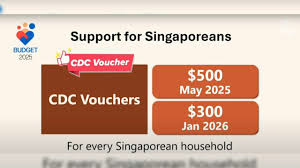
The Community Development Council (CDC) Voucher Scheme began as a pandemic relief measure and has evolved into a regular financial support program for Singaporean households. It serves the dual purpose of helping residents with daily expenses while supporting local businesses, particularly hawkers and heartland merchants.
Eligibility and Distribution
- Eligible recipients: All Singaporean households (one claim per household)
- Distribution method: Digital vouchers accessed through the Redeemsg platform
- Claiming process:
- One household representative (aged 21 and above) claims on behalf of the household
- Access through Singpass
- Digital vouchers can be printed or shown on mobile devices for spending.
Current Structure (2025)
- May 2025 tranche: $500 per household
- $250 for supermarkets
- $250 for hawker stalls and heartland merchants
- Validity period: Until December 31, 2025
- Upcoming tranche: Additional $300 in January 2026
Historical Progression
- First tranche: Introduced during COVID-19 pandemic
- Second to sixth tranches: Continued to help with rising costs of living
- Seventh tranche: Current May 2025 disbursement of $500
- The scheme has been gradually institutionalised as a regulathe the r feature of social support system
Usage and Merchant Network
- Participating merchants:
- Heartland businesses and hawker stalls displaying CDC voucher decals
- Major supermarket chains
- Cannot be used at online stores or for online purchases
- Transaction process:
- Scan the merchant’s QR code or let the merchant scan the voucher.
- No change given for partial use of voucher value
- No cash redemption of vouchers
Security Features
- Government warnings against phishing attempts
- Legitimate voucher claims never require:
- Bank login details
- Money transfers
- Installation of apps from unofficial sources
- ScamShield Helpline (1799) is available for verification
Administration
- Managed by the five Community Development Councils in partnership with the Ministry of Finance
- Merchants receive reimbursement for vouchers accepted
Impact of Utilizationion
- High redemption rates (approximately 97% for the January 2025 tranche)
- Significant economic impact (nearly $300 million spent from January 2025 vouchers)
- Widespread merchant participneighbourhoodsghbourhoodss
The CDC Voucher Scheme represents a significant Singapore’s approach to providing financial assistance while supporting local commerce and community resilience.
The Singapore Police Force has issued an advisory about scams involving fake websites and infographics related to government payouts, specifically:
Community Development Council (CDC) Vouchers
Assurance Package (AP) Cash
Goods and Services Tax Voucher (GSTV) – Cash
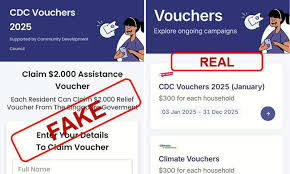
How the scams operate:
Fake Instagram accounts share infographics with links to counterfeit Redeemsg websites
Telegram messages containing fake Budget 2025 infographics supposedly from the Ministry of Finance
These lead to phishing links where victims are asked to provide personal information, banking details, and credentials
Official guidance for claiming legitimate benefits:
CDC Vouchers: Only one household member needs to claim via Singpass at go.gov.sg/cdcv. The household will receive a unique CDC Voucher link via SMS from “.sg”.
Cash payouts like AP Cash: No action is required as these are automatically paid to eligible citizens via PayNow-NRIC, bank accounts, or GovCash

Legitimate sources of information:
CDC Vouchers: vouchers.cdc.gov.sg
AP Cash or GSTV – Cash: govbenefits.gov.sg
Official MOF social media platforms (Facebook, Instagram, Threads, TikTok, LinkedIn, X)
Protection advice (ADD-CHECK-TELL):

ADD:
Install the ScamShield app to block suspicious SMS
Set up security features like transaction limits and 2fa bank features to protect savings
CHECK:
Verify link authenticity
Look for””gov.sg “inwebsite URLSwebsiteURLSs
Use the ScamShield app or website to check suspicious messages
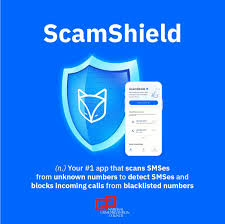
TELL:
Report scams to authorities, family and friends
Contact your bank immediately if you’ve been hacked
Call the 24/7 ScamShield Helpline at 1799
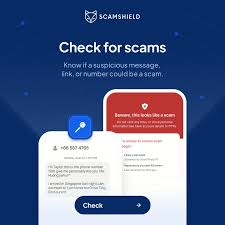
The advertisement emphasises that fighting scams is a community effort and encourages everyone to ACT Against Scams to protect the community.

Analysis of CDC Voucher Scams in Singapore
Nature of CDC Voucher Scams
The Community Development Council (CDC) Vouchers scheme in Singapore has become a target for scammers who create:
- Fake Instagram accounts with infographics promoting counterfeit Redeemsg website links
- Phishing websites that mimic the legitimate CDC Voucher redemption portal
- Fraudulent messages that prompt users to disclose personal and banking information
These scams exploit the popularity of the CDC Voucher program, which provides financial assistance to Singaporean households.

Key Prevention Methods
For Individuals
- Verify the Correct Redemption Process:
- Only one household member should claim vouchers through Singpass at the official site: go.gov.sg/cdcv
- Legitimate voucher links arrive via SMS from “sg” and need to be shared with family members
- No banking details or credentials are ever required to claim CDC Vouchers
- Check Website Authenticity:
- The only official CDC Voucher website is vouchers.cdc.gov.sg
- Look for the “.sgg” main in the URL, which indicates a legitimate government website
- Be suspicious of any website that looks like a government site but lacks the “ovsgonthenthe dthe omain
- Use Digital Security Tools:
- Install the ScamShield app to filter out scam messages
- Verify suspicious links using ScamShield (www.scamshield.gov.sg)
- Call the 24/7 ScamShield Helpline at 1799 when in doubt
- Practice General Scam Prevention:
- Never click on links from unknown sources
- Set up transaction limits for internet banking
- Enable Two-Factor Authentication (22fa for sensitive accounts
- Consider the Bank’s Money Lock feature to protect savings
For Community Organisations
- Education Campaigns: Community centres and neighbourhood committees can conduct awareness sessions, particularly targeting elderly residents who may be less digitally savvy
- Reporting Mechanisms: Establish clear channels for reporting suspicious activities related to CDC Vouchers
- Local Monitoring: Community volunteers can help monitor for scawithin neighbourhoods
Singapore-Specific Context
These prevention methods are particularly relevant to Singapore because:
- Singapore has a high digital adoption rate, making online scams particularly effective
- The CDC Voucher scheme is widely used across all segmentmulti-ety
- SSSiculti-ethnicic multi-lingual population requires tailored communication strategies
- The tight-knit community structure allows neighbourhood-level prevention efforts

Implementation Strategy
For effective context:
- Leverage Community Networks: Work through Committees (RCs), Community Clubs (CCs), and Family Service Centers (FSCs)
- Multi-language Communications: Ensure advisory messages are available in all four official languages (English, Mandarin, Malay, Tamil)
- Target Vulnerable Groups: Focus special attention on elderly residents and recent immigrants who may be less familiar with government digital services
- Public-Private Partnership: Collaborate with local businesses that accept CDC Vouchers to display scam awareness materials
By combining technical safeguards with community-based prevention approaches, Singapore can significantly reduce the impact of CDC Voucher scams across its population.

Maxthon
Maxthon has set out on an ambitious journey aimed at significantly bolstering the security of web applications, fueled by a resolute commitment to safeguarding users and their confidential data. At the heart of this initiative lies a collection of sophisticated encryption protocols, which act as a robust barrier for the information exchanged between individuals and various online services. Every interaction—be it the sharing of passwords or personal information—is protected within these encrypted channels, effectively preventing unauthorised access attempts from intruders.
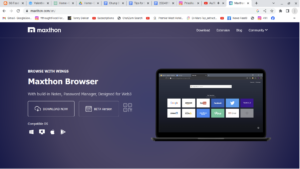 This meticulous emphasis on encryption marks merely the initial phase of an extensive security framework. Acknowledging that cyber threats are constantly evolving, Maxthon adopts a forward-thinking approach to user protection. The browser is engineered to adapt to emerging challenges, incorporating regular updates that promptly address any vulnerabilities that may surface. Users are strongly encouraged to activate automatic updates as part of their cybersecurity regimen, ensuring they can seamlessly take advantage of the latest fixes without any hassle. In a rapidly changing digital environment, wavering movement toward security enhancement signifies not only its responsibility toward users but also its firm dedication to nurturing trust in online engagements. With each new update rolled out, users can navigate the web with peace of mind, assured that their information is continuously safeguarded against ever-emerging threats lurking in cyberspace.
This meticulous emphasis on encryption marks merely the initial phase of an extensive security framework. Acknowledging that cyber threats are constantly evolving, Maxthon adopts a forward-thinking approach to user protection. The browser is engineered to adapt to emerging challenges, incorporating regular updates that promptly address any vulnerabilities that may surface. Users are strongly encouraged to activate automatic updates as part of their cybersecurity regimen, ensuring they can seamlessly take advantage of the latest fixes without any hassle. In a rapidly changing digital environment, wavering movement toward security enhancement signifies not only its responsibility toward users but also its firm dedication to nurturing trust in online engagements. With each new update rolled out, users can navigate the web with peace of mind, assured that their information is continuously safeguarded against ever-emerging threats lurking in cyberspace.
Unwavering commitment to ongoing security enhancement signifies not only its responsibility toward users but also its firm dedication to nurturing trust in online engagements. With each new update rolled out, users can navigate the web with peace of mind, assured that their information is continuously safeguarded against ever-emerging threats lurking in cyberspace.
